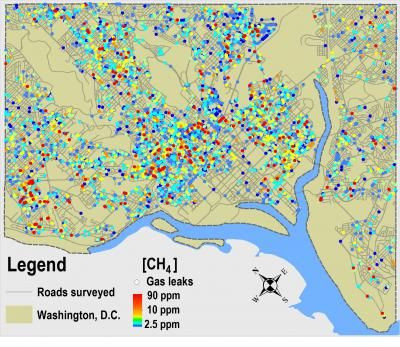More Than 5,900 Gas Leaks Found In Washington, D.C., ‘Surprising’ Methane Levels Detected [PHOTO]

The nation’s capital contains thousands of gas leaks, dozens of which pose a risk of explosion, a new study suggests.
The findings, published in the journal Environmental Science & Technology, reveal more than 5,893 gas leaks from old natural gas pipelines under the streets of Washington, D.C. A team of researchers from Duke University and Boston University used a car to drive down every street in the city with measuring instruments to detect the leaks last January and February.
In some cases, researchers found manholes with methane concentrations 10 times greater than the threshold at which explosions occur -- 500,000 parts per million of natural gas. The average leaks were 2.5 times higher than background air samples collected in the city.
"If you dropped a cigarette down a manhole ... it could have blown up," Robert Jackson, professor of environmental sciences at Duke University, who led the study, told USA Today. "I was shocked."
While some of the thousands of leaks were found at high levels, most posed no health or safety risk to the general public. Rather, they could contribute to climate change by catalyzing ozone formation.
While the team says gas companies usually respond quickly to reports of gas leaks, they can be limited to how much they can spend to repair the pipes. Four months after leaks were reported to city authorities, the team found that nine were still emitting dangerous levels of methane.
"Finding the leaks a second time, four months after we first reported them, was really surprising,” Jackson said.
Critics of the study say the results my lead to unnecessary panic. Betty Ann Kane, chairwoman of the D.C. Public Service Commission, denies the city has 5,000 leaks and says there hasn't been an accident or explosion there for at least 20 years.
Last year, the same research team conducted a similar study in Boston. "The average density of leaks we mapped in the two cities is comparable, but the average methane concentrations are higher in Washington," Nathan G. Phillips, a professor at Boston University's Department of Earth and Environment, said comparing the two studies.
Both cities suffer from an aging infrastructure, where underground cast-iron pipes were installed during the early 20th century to carry gas. “Aging infrastructure is more than roads and bridges,” Phillips told the Washington Post. “It’s the infrastructure that we can’t see.”
© Copyright IBTimes 2024. All rights reserved.





















